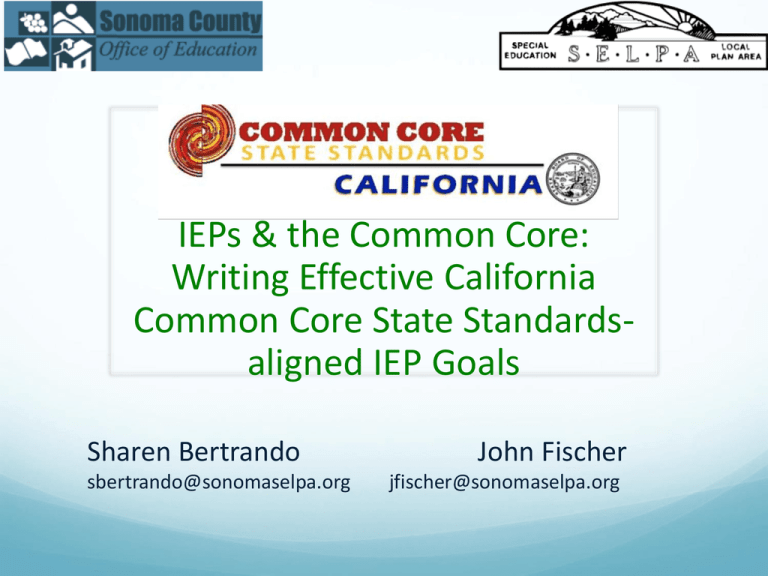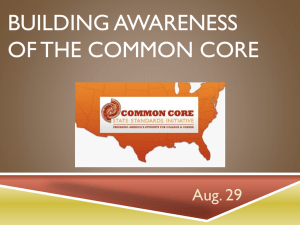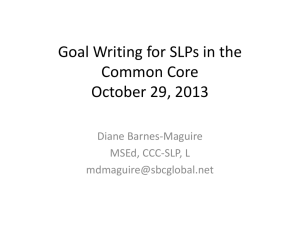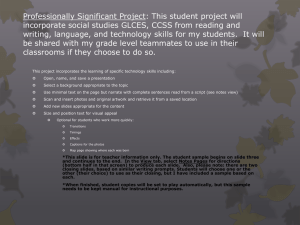Writing Effective CCSS-Aligned IEP Goals Powerpoint presenation
advertisement

IEPs & the Common Core: Writing Effective California Common Core State Standardsaligned IEP Goals Sharen Bertrando sbertrando@sonomaselpa.org John Fischer jfischer@sonomaselpa.org Welcome Introduction Who is in the room? Logistics Overview of Training California Common Core State Standards (CA CCSS) Know K-W-L Want to know Learn Today’s Objectives Participants will be able to . . . • Recognize the instructional shifts needed to implement CA CCSS • State the importance of access to CA CCSS for students with disabilities • Define your roles in implementing CA CCSS for students with disabilities • Practice developing and writing CA CCSS IEP goals aligned to students’ present levels of academic and functional performance (PLAAFP) The toolkit for writing CA CCSS aligned IEP goals Anchor Standards for College and Career Readinesshttp://www.corestandards.org/ELA-Literacy/CCRA/L/ Application for Students with Disabilities http://www.cde.ca.gov/sp/se/cc/ California’s Common Core State Standards for English Language Arts & Literacy in History/Social Studies, Science, and “Technical Subjects” http://cde.videossc.com/archives/120213/ California Department of Education Common Core Resources for Special Education http://www.cde.ca.gov/sp/se/cc/ 5 The toolkit for writing CA CCSS aligned IEP goals Common Core Shifts https://www.engageny.org/resource/common-core-shifts Cognitive Rigor Matrix http://www.karin-hess.com/#!TheHess-Cognitive-Rigor-Matrix/cmbz/7C5E6A13-1611-4CC5BC84-1074B05080BC 12 Goal Writing Considerations for IEPs http://www.calstat.org/specialEdgeOld.html Goal Writing Template – SCOE/SELPA Standards for Math Proficiency Matrix http://mathleadership.com 6 Taking a Closer Look . . . http://www.corestandards.org/ Pedagogical Instructional Shifts of the Core ELA/Literacy Mathematics http://www.engageny.org/sites/default/files/resource/attachments/common-core-shifts.pdf Pedagogical Instructional Shifts of the Core Examine standards and instructional shifts. Consider the implications of these shifts for students with disabilities. Be ready to share out using the following sentence frame . . . If students have to . . . then teachers have to . . . http://www.engageny.org/sites/default/files/resource/attachments/common-core-shifts.pdf Shifts of the Core – Examples ELA/Literacy Math 4. Text-based answers 6. Dual Intensity If students have to develop questions that increasingly engage others then teachers have to model questioning and highlight different purposes of questions. If students have to solve word problems and reflect on the reasonableness of their responses then teachers have to design tasks that have multiple entry points and opportunity for reflection. Sonoma County Office of Education SELPA Pedagogical Instructional Shifts of the Core Examine standards and instructional shifts. Consider the implications of these shifts for students with disabilities. Be ready to share out using the following sentence frame . . . If students have to . . . then teachers have to . . . http://www.engageny.org/sites/default/files/resource/attachments/common-core-shifts.pdf Before and After the Core https://www.engageny.org/resource/video-blog-math-beforeand-after-common-core 12 California Department of Education Common Core State Standards Symposium for Special Educators Aligning IEPs and the CCSS http://www.cde.videossc.com/archives/032114 Anchor Standards http://www.cde.videossc.com/archives/032114 Navigating the ELA/Literacy Standards http://www.cde.videossc.com/archives/032114 15 An integrated model of literacy Although the Standards are divided into Reading, Writing, Speaking and Listening, and Language strands for conceptual clarity, the processes of communication are closely connected, as reflected throughout this document. For example, Writing standard 9 requires that students be able to write about what they read. Likewise, Speaking and Listening Standard 4 sets the expectation that students will share findings from their research. -Sacramento County of Education CCSS Document p. 3 http://www.cde.videossc.com/archives/032114 CA CCSS for ELA Content Overview Coding 3.SL.3 GRADE STRAND STANDARD Navigating the ELA/Literacy Standards In Pairs or Triads use the template and color coding guide to explore the structure of the ELA/literacy standards assigned within grade level and across grade levels. What is the student expected to know and be able to do? Discuss changes in teaching pedagogy to support students with disabilities to master these standards. Be ready to share out whole group. 18 COLLEGE AND CAREER READINESS ANCHOR STANDARDS FOR READING 1.Reading Standards for Literature K–5 2.Reading Standards for Informational Text K–5 3.Reading Standards: Foundational Skills K–5 COLLEGE AND CAREER READINESS ANCHOR STANDARDS FOR WRITING 1.Writing Standards K–5 COLLEGE AND CAREER READINESS ANCHOR STANDARDS FOR SPEAKING AND LISTENING 1.Speaking and Listening Standards K–5 COLLEGE AND CAREER READINESS ANCHOR STANDARDS FOR LANGUAGE 1.Language Standards K–5 19 COLLEGE AND CAREER READINESS ANCHOR STANDARDS FOR READING 1.Reading Standards for Literature 6–12 2.Reading Standards for Informational Text 6–12 COLLEGE AND CAREER READINESS ANCHOR STANDARDS FOR WRITING 1.Writing Standards 6–12 COLLEGE AND CAREER READINESS ANCHOR STANDARDS FOR SPEAKING AND LISTENING 1.Speaking and Listening Standards 6–12 COLLEGE AND CAREER READINESS ANCHOR STANDARDS FOR LANGUAGE 1.Language Standards 6–12 20 BLOOM’S TAXONOMY Remembering Understanding Applying Can the student recall or remember the info.? Can the student explain ideas or concepts? Can the student use the info. in a new way? define duplicate list memorize recall repeat reproduce state classify describe discuss explain identify locate recognize report select translate paraphrase choose demonstrate dramatize employ illustrate interpret operate schedule sketch solve use write. http://www.c de.videossc.c om/archives/ 032 Analyzing Can the student distinguish between the different parts? appraise compare contrast criticize differentiate discriminate distinguish examine experiment question Test Evaluating Can the student justify a stand or decision? appraise argue defend judge select support value evaluate Creating Can the student create new product or point of view? assemble, construct create design develop formulate write http://www.cde.videossc.com/archives/032114 DEPTH OF KNOWLEDGE LEVELS (The Depth of Knowledge is not determined by the verb, but what comes after the verb and the context in which the verb is used, i.e., the depth of thinking required. Level 1: Recall and Reproduction Requires recall of information, such as a fact, definition, term, or performance of a simple process or procedure. Answering a level 1 item involves following a simple, well-known procedure or formula. Simple skills and abilities or recall characterize this level. Level 2: Skills/Concepts Includes the engagement of some mental processing beyond recalling or reproducing a response. Items require students to make some decisions as to how to approach the question or problem. These actions imply more than one mental or cognitive process/step. Level 3: Strategic Thinking: Requires deep understanding as exhibited through planning, using evidence, and more demanding cognitive reasoning. The cognitive demands at this level are complex and abstract. An assessment item that has more than one possible answer and requires students to justify the response they give would most likely be a Level 3. Level 4: Extended Thinking Requires high cognitive demand and is very complex. Students are expected to make connections – relate ideas within the content or among content areas – and have to select or devise one approach among many alternatives on how the situation can be solved. Due to the complexity of cognitive demand, this level often requires an extended period of http://www.cde.videossc.com/archives/032114 time. Depth of Knowledge Activities http://www.cde.videossc.com/archives/032114 Cognitive Rigor Matrix – Reading (khess@nciea.org) Revised Bloom’s Taxonomy Webb’s DOK Level 1 Recall & Reproduction Remember o Retrieve knowledge from longterm memory, recognize, recall, locate, identify o Understand Construct meaning, clarify, paraphrase, represent, translate, illustrate, give examples, classify, categorize, summarize, generalize, infer a logical conclusion), predict, compare/contrast, match like ideas, explain, construct models o o o o Recall, recognize, or locate basic facts, details, events, or ideas explicit in texts Read words orally in connected text with fluency & accuracy Define terms Identify or describe literary elements (characters, setting, sequence, etc.) Select appropriate words when intended meaning/definition is clearly evident Describe/explain who, what, where, when, or how Webb’s DOK Level 2 Skills & Concepts Webb’s DOK Level 3 Strategic Thinking/ Reasoning Webb’s DOK Level 4 Extended Thinking o Specify, explain, show relationships; explain why, causeeffect Give non-examples/examples Summarize results, concepts, ideas Make basic inferences or logical predictions from data or texts Identify main ideas or accurate generalizations of texts Locate information to support explicit-implicit central ideas Use context to identify the meaning of words/phrases Obtain and interpret information using text features o Explain, generalize, or connect ideas using supporting evidence (quote, example, text reference) Identify/ make inferences about explicit or implicit themes Describe how word choice, point of view, or bias may affect the readers’ interpretation of a text o o Apply a concept in a new context o Illustrate how multiple themes (historical, geographic, social) may be interrelated Categorize/compare literary elements, terms, facts, details, events Identify use of literary devices Analyze format, organization, & internal text structure (signal words, transitions, semantic cues) of different texts Distinguish: relevant-irrelevant information; fact/opinion Identify characteristic text features; distinguish between texts, genres o Analyze information within data sets or texts Analyze interrelationships among concepts, issues, problems Analyze or interpret author’s craft (literary devices, viewpoint, or potential bias) to critique a text Use reasoning, planning, and evidence to support inferences o Analyze multiple sources of evidence, or multiple works by the same author, or across genres, time periods, themes Analyze complex/abstract themes, perspectives, concepts Gather, analyze, and organize multiple information sources Analyze discourse styles Evaluate relevancy, accuracy, & completeness of information from multiple sources Draw & justify conclusions Apply understanding in a novel way, provide argument or justification for the application Synthesize information across multiple sources or texts Articulate a new voice, alternate theme, new knowledge or perspective o o o o o Apply Carry out or use a procedure in a given situation; carry out (apply to a familiar task), or use (apply) to an unfamiliar task Analyze Break into constituent parts, determine how parts relate, differentiate between relevantirrelevant, distinguish, focus, select, organize, outline, find coherence, deconstruct (e.g., for bias or point of view) o o Use language structure (pre/suffix) or word relationships (synonym/antonym) to determine meaning of words o Identify whether specific information is contained in graphic representations (e.g., map, chart, table, graph, Tchart, diagram) or text features (e.g., headings, subheadings, captions) o o o o o o o o o o o Evaluate Make judgments based on criteria, check, detect inconsistencies or fallacies, judge, critique Create Reorganize elements into new patterns/structures, generate, hypothesize, design, plan, produce o o o o o o o Cite evidence and develop a logical argument for conjectures Describe, compare, and contrast solution methods Verify reasonableness of results Critique conclusions drawn Generate conjectures or o Synthesize information within one o or prior knowledge and experience o Develop a complex model for a given situation Develop an alternative solution o o o o o o Explain how concepts or ideas specifically relate to other content domains or concepts Develop generalizations of the results obtained or strategies used and apply them to new problem situations source or text hypotheses based on observations http://www.karin-hess.com/#!The-Hess-Cognitive-Rigor-Matrix/cmbz/7C5E6A13-1611-4CC5-BC84-1074B05080BC o Reflection How can these tools assist in the development and implementation of CA CCSS aligned IEP goals for my students? 25 Standards for Mathematical Practice “The Standards for Mathematical Practice describe varieties of expertise that mathematics educators at all levels should seek to develop in their students. These practices rest on important ‘processes and proficiencies’ with longstanding importance in mathematics education.” (CCSS, 2010) 26 Structuring the Practices http://www.azed.gov/wp-content/uploads/PDF/MathOverview.pdf 27 Mathematical Practices – T-P-S 1. Individually review the Standards for Mathematical Practice. 2. With a partner at your table discuss a new insight you had into the Standards for Mathematical Practice. 3. Discuss the following question: Adapted from the National Council of Supervisors of Mathematics Illustrating the Standards for Mathematics Practice, Reasoning, and Explaining 28 Mathematical Practices – T-P-S Discuss the following question: What implications might the Standards for Mathematical Practice have for teachers? For your role as accelerating the learning of students receiving special education services? Adapted from the National Council of Supervisors of Mathematics Illustrating the Standards for Mathematics Practice, Reasoning, and Explaining 29 Buttons Task As you watch the following video think about: The teacher’s reflections about pedagogical practices. The strategies and tools provided to the students. Student discussions and actions. http://www.mathedleadership.org/ccss/itp/button.html National Council of Supervisors of Mathematics Illustrating the Standards for Mathematics Practice, Reasoning, and Explaining 30 CCSS Mathematics Placemats http://www.azed.gov/azccrs/mathstandards/k-2/ 31 CA CCSS for Math Content Overview Example Grades K-8 Example High School 4.OA.A.2 HS.A-SSE.A.2 Grade Domain Cluster Standard# Grade Domain Conceptual Cluster Standard Category Writing Standards Aligned CA CCSS IEP Goals California Department of Education 34 Results Driven Accountability (RDA) Writing meaningful and measurable annual goals aligns with RDA core principles: Drives improved outcomes for all children and youth with disabilities. Ensures the protection of the individual rights of each child or youth with a disability and their families. Is responsive to the needs and expectations of the ultimate consumers as they identify them. Evaluation/Eligibility • • Educational Impact statement Educational needs resulting from the disability Present Levels of Academic Achievement and Functional Performance •Where is he/she currently performing in the general curriculum as related to the CA CCSS? Measurable Annual Goals What skill(s) does he/she need to achieve in order to make progress in the general curriculum? Present Levels of Academic and Functional Performance (PLAAFP) 1. A description of the student’s: • Strengths • Learning needs/challenges • Progress in general education curriculum 2. Measurable baseline for IEP goals 3. Linked between: • Present levels and goals • Recent evaluation and current classroom data Data Resources Parent Student General Education Teacher Special Education teacher Related Service Providers Evaluation reports Previous IEP Data Resources Parent Student General Education Teacher Special Education teacher Related Service Providers Evaluation reports Previous IEP PLAAFP Sources 1. At your tabletop, one member takes an index card. 2. State your idea, write it down on the index card, and pass the card to your shoulder partner. 3. Repeat until all members at your table have participated. 4. Assign a leader to share out whole group. PLAAFP Content All areas pertinent to the student’s needs Information related to the disability IDEA indicates that a child may have other educational needs that result from the disability Identified needs may not require a goal, however they must be addressed Special Factors 34 C.F.R. §300.324(a)(2)(i)-(v) The team must consider a child's behavior problems when developing the IEP. If a child has limited English proficiency, the team must consider the child's language needs and provide services to meet these needs. If a child is blind or visually impaired, the team must decide about teaching the child to use Braille. If a child is deaf or hearing impaired or has communication problems, the IEP team must meet the child's communication and language needs. The school is responsible for considering whether a child's needs assistive technology devices and services. 44 IDEA 2004 A statement of measurable annual goals, including academic and functional goals designed to— (A) Meet the child’s needs that result from the child’s disability to enable the child to be involved in and make progress in the general education curriculum; and (B) Meet each of the child’s other educational needs that result from the child’s disability. 300.320(2) (i) Components for a Measureable Goal Identify grade level state standards Identify strengths and needs Identify educational impact Develop a meaningful annual goal Ensuring Access to the Common Core for ALL Students 47 Goals Aligned to CA CCSS Adapted from Kleinert & Kearns (2010). Alternate Assessment: for students with significant cognitive disabilities, Baltimore, MA: Brooks Publishing Co. Alternate forms: Same level of cognition but different response format Critical function of the standard: Modification of the level and complexity accomplishing the same purpose or outcome Access skills in content activities: Basic skills are embedded in standards-based activities Access to the General Curriculum Standard as written: Narrowly or broadly stated Standard: Reading Strand for Literature Grade 5 – Integration of Knowledge and Ideas – Compare and contrast stories in the same genre (e.g., mysteries and adventure stories) on their approaches to similar themes and topics. (5.RL.9) More complex Less Complex Standards-based IEP Goal With Accommodations Compare and contrast characters in stories Compare and contrast characters in stories by using a speech to text recognition software With Modifications Compare and contrast characters in stories using picture/symbols icons Essential Understandings Reach and grasp icons to match character attributes as directed by peer Activate switch to select choice of literature to be read/discussed Turn head in the direction of speaker Adapted from Kleinert & Kearns (2010); http://www.doe.mass.edu/mcas/alt/ Sonoma County Office of Education SELPA The Features of Critical Skills 1. Are required to complete part or all of an activity 2. Are generalized through repetitions throughout the day 3. Are not components of the curriculum 4. Are linked to content standards to ensure access for students with disabilities The Essential IEP Elements 1. The critical skills must be identified and addressed in the 2. 3. 4. 5. goals and objectives. Instruction must be provided in a meaningful, functional context in order for the student to acquire skills. The supports and adaptations must be implemented for the student to learn critical skills within the identified contexts. These skills can be taught within the context of natural routines (i.e., Within the curriculum content areas). The connection between the critical skills and goals increases the chance for acquisition of the skills. Grisham-Brown & Kearns, 2001 Non-negotiable Components for Writing a Measureable Goal Correlates between goal and PLAAFP Describes skill and level of performance Meets the child’s needs Enables progress in the general curriculum. Includes short term objectives if the student is participating in alternative assessment (NCSC) Non-negotiable Components for Writing a Measureable Goal Intended direction of change increase or decrease Baseline performance academic or functional Level of attainment Measure of proficiency Conditions timeline for attainment, frequency, independent or with assistance How do you measure progress? At your tabletops . . . 1. Discuss the types of measurement tools that you currently use in writing your measurable goals. 2. Discuss new types of measurement tools that you would like to use. 3. Be prepared to share out. Putting It All Together 1. Select a case study (or one that you brought). 2. Use the IEP toolkit to develop and write a goal based on the student’s PLAAFP. 3. Share your written goal with a partner. 4. Evaluate each other’s goal using the Writing IEPs with the Common Core Critical Questions handout 5. Discuss with your partner. California Common Core State Standards (CA CCSS) K-W-L Know Want to know Learned Learn Next





